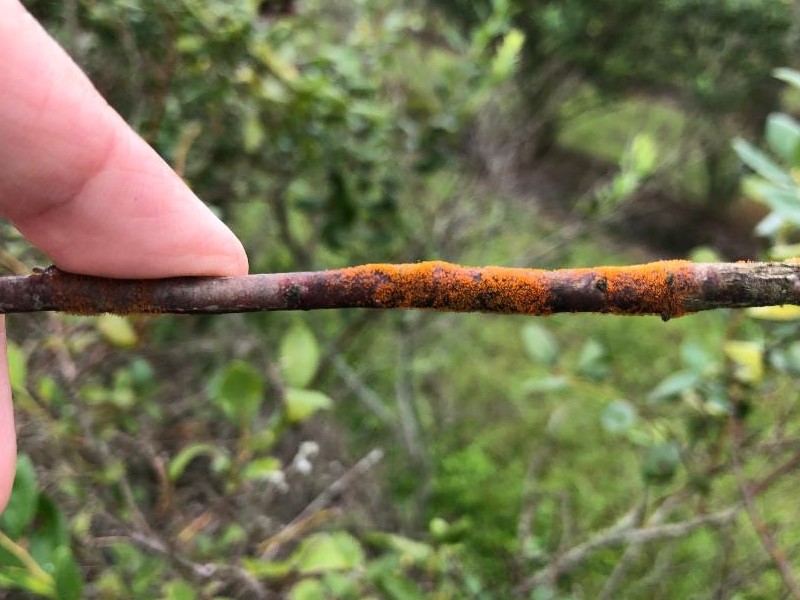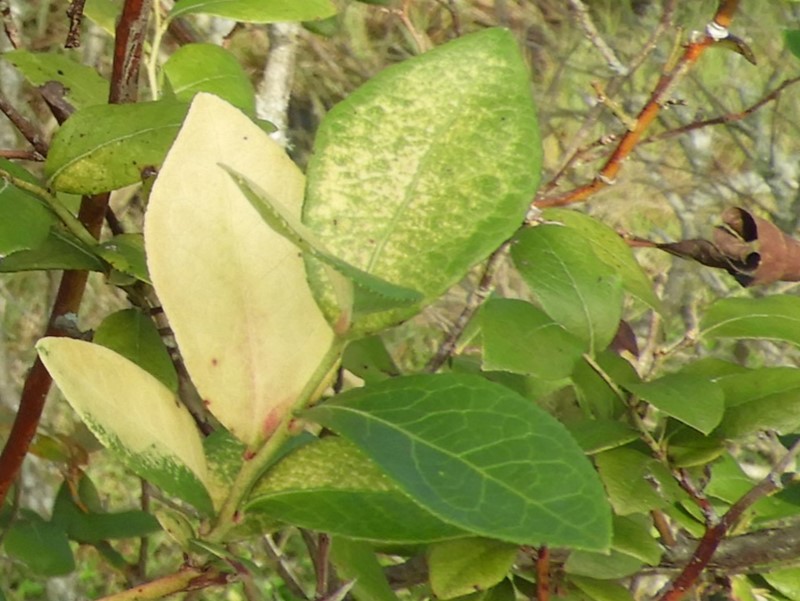By Jonathan Oliver
Wet weather during 2021 contributed to the development of several significant disease issues on Georgia blueberries. Throughout the summer of 2021, rainfall across Georgia’s blueberry production belt was considerably above normal, and issues with phytophthora root rot and algal stem blotch were widely reported across southern Georgia during late summer and fall.
Phytophthora root rot is one of the most frequently diagnosed disease issues on Georgia blueberries, and since very wet conditions favor the development of this disease, it is not surprising that significant problems with phytophthora root rot were observed during 2021. However, issues with algal stem blotch have heretofore not been common on Georgia blueberries.

SPECIES AND SPREAD
In contrast to the fungal, bacterial or viral diseases that typically afflict crop plants, algal stem blotch, as the name indicates, is actually caused by a species of parasitic alga. This, in and of itself, makes it an oddity in the disease world, and it is not something that has been widespread in Georgia blueberry fields previously.
The cause of algal stem blotch of blueberry is the parasitic algal species Cephaleuros virescens. This species is known to infect numerous plant species in tropical and subtropical climates worldwide. It causes significant diseases of tea, coffee and coconuts. In the southeastern United States, this species causes algal leaf spot on magnolia and camellia and is also the cause of orange cane blotch (orange felt disease) on blackberries.
On southern highbush blueberries, algal stem blotch is primarily a significant issue during wet, humid conditions. Water is critical to the life cycle of C. virescens. This species produces spores that are motile in water, so rainsplash and wind-driven rain are believed to be critical for the spread of this pathogen to susceptible host tissue. In addition, it has been suggested that stress caused by insects, mites, diseases and the environment can predispose plants to infection with this alga.

STRIKING SYMPTOMS
Algal stem blotch causes red blotches that appear on the juvenile stems of blueberry plants. These blotches result from the growth of the alga beneath the stem cuticle (the outermost waxy layer of the stem). As infected stems age and become woody, these lesions may be less obvious until the alga sporulates through the bark, forming feltlike mats of bright orange sporangiophores (algal spore-producing structures).
Another striking symptom of algal stem blotch on infected stems is chlorosis (yellowing) or bleaching (whitening) of leaves. While this bleaching can resemble nutrient deficiencies or other disease issues, it often has an irregular (less uniform) or “blotchier” (speckled) appearance on affected leaves. Rather than uniformly affecting the entire plant, the bleaching may occur on only a few infected stems per plant.
Defoliation of affected stems can occur. Plants severely affected by algal stem blotch can lack vigor and fail to regrow after summer pruning. Since blueberry plants fruit on 1-year-old wood, a lack of new growth in one season is likely to significantly impact yield during the subsequent growing season.
MANAGEMENT METHODS
Management of algal stem blotch on blueberry can be very challenging. Cultural practices are recommended to reduce the establishment and spread of C. virescens. Using disease-free planting stock can reduce the initial establishment of disease in new plantings. Reducing plant stress (via proper fertilization, disease and pest management, and sanitation) can reduce plant susceptibility to algal stem blotch.
Given the importance of water in the life cycle of the alga, practices that reduce moisture within the plant canopy are likely to reduce issues with algal stem blotch. Avoiding overhead irrigation can reduce the spread of the algal spores. Eliminating weeds can help with air circulation and keep the canopy drier and less hospitable to algal development.
Since this disease is caused by an alga rather than a fungus, it is unlikely that most fungicides will be effective for management. Sprays with copper-containing fungicides have been suggested to reduce algal sporulation and thereby protect healthy canes from infection. However, these products are not useful for eradication of the disease or elimination of existing symptoms.
Jonathan Oliver is an assistant professor at the University of Georgia College of Agricultural and Environmental Sciences in Tifton.









